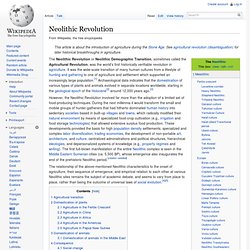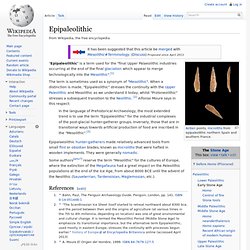

Neolithic Revolution. However, the Neolithic Revolution involved far more than the adoption of a limited set of food-producing techniques.

During the next millennia it would transform the small and mobile groups of hunter-gatherers that had hitherto dominated human history into sedentary societies based in built-up villages and towns, which radically modified their natural environment by means of specialized food-crop cultivation (e.g., irrigation and food storage technologies) that allowed extensive surplus food production. These developments provided the basis for high population density settlements, specialized and complex labor diversification, trading economies, the development of non-portable art, architecture, and culture, centralized administrations and political structures, hierarchical ideologies, and depersonalized systems of knowledge (e.g., property regimes and writing).
Neolithic. An array of Neolithic artifacts, including bracelets, axe heads, chisels, and polishing tools.

Neolithic stone implements are by definition polished and, except for specialty items, not chipped. The Neolithic Era, or Period, from νέος (néos, "new") and λίθος (líthos, "stone"), or New Stone age, was a period in the development of human technology, beginning about 10,200 BC, according to the ASPRO chronology, in some parts of the Middle East, and later in other parts of the world[1] and ending between 4,500 and 2,000 BC.
Traditionally considered the last part of the Stone Age, the Neolithic followed the terminal Holocene Epipaleolithic period and commenced with the beginning of farming, which produced the "Neolithic Revolution". It ended when metal tools became widespread (in the Copper Age or Bronze Age; or, in some geographical regions, in the Iron Age). Epipaleolithic. "Epipaleolithic" is a term used for the "final Upper Palaeolithic industries occurring at the end of the final glaciation which appear to merge technologically into the Mesolithic".[1] The term is sometimes used as a synonym of "Mesolithic".

When a distinction is made, "Epipaleolithic" stresses the continuity with the Upper Paleolithic and Mesolithic as we understand it today, whilst "Protoneolithic" stresses a subsequent transition to the Neolithic. [2] Alfonso Moure says in this respect: In the language of Prehistorical Archaeology, the most extended trend is to use the term "Epipaleolithic" for the industrial complexes of the post-glacial hunter-gatherer groups. Inversely, those that are in transitional ways towards artificial production of food are inscribed in the "Mesolithic".[3] Epipalaeolithic hunter-gatherers made relatively advanced tools from small flint or obsidian blades, known as microliths that were hafted in wooden implements.